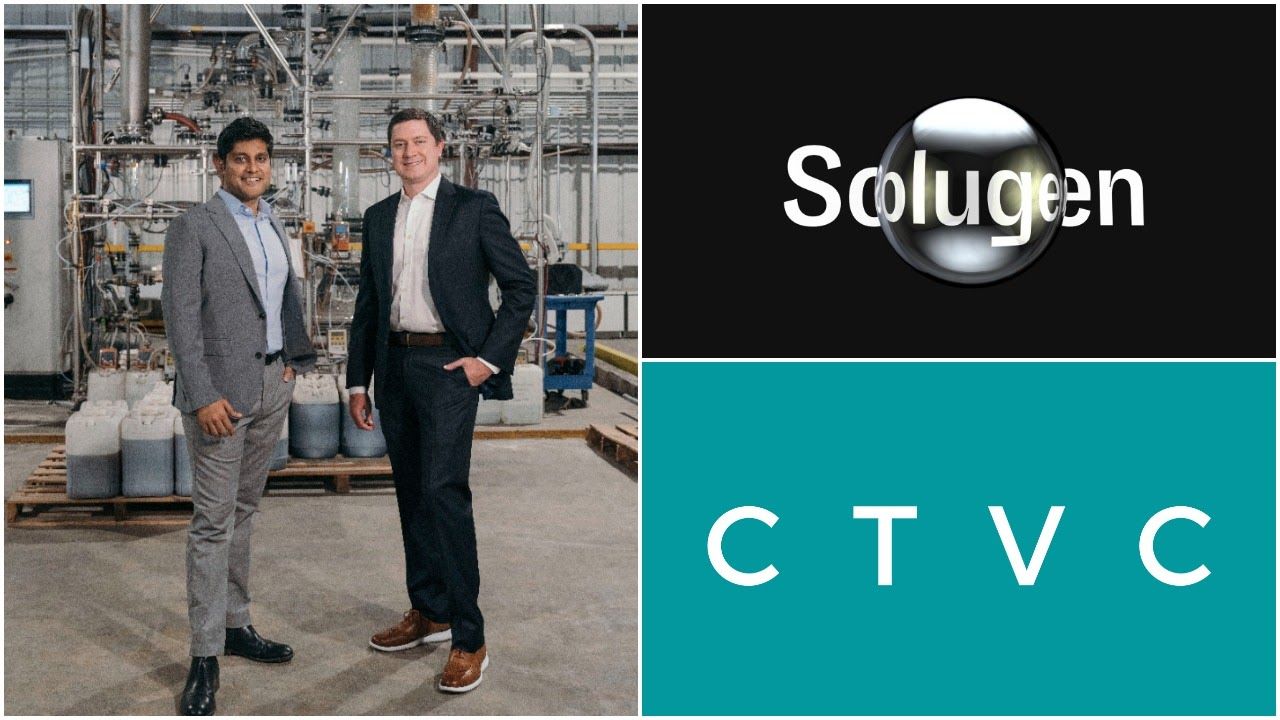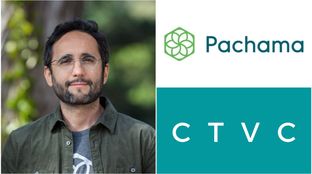
🌎 Get ready with me: Government grants edition 💅💵
A founder’s guide to winning non-dilutive funding with Elemental Excelerator
Solugen raises a $350m Series C - how did they get here?

We Zoomed in to Houston, TX to catch up with the founders of Solugen, Gaurab and Sean, during the crowning of climate tech’s newest unicorn. Solugen announced a $350m Series C at a $1.8b valuation from a roster of legacy private equity investors. The company’s chemienzymatic platform makes the building blocks of the chemicals industry cheaper, faster, and more sustainably than petrochemistry. As Seth Bannon, Partner at Fifty Years who led Solugen’s pre-seed round in 2016, puts it, “If things go well, Solugen will not only be the first carbon negative chemicals company but also the world's first trillion dollar chemicals company. That's easy to get excited about. This was a competitive round because there aren't that many $2b companies, growing revenue 300% year over year, with 100x growth potential ahead.” We roll the clock back for the full story on how Gaurab and Sean went from poker pals to the helm of a generational chemicals company.
What’s the size of the chemicals emissions problem?
G: Massive! For some context, the chemicals industry is one of the biggest industries in the world; it generates ~$6T in annual revenue with even higher downstream numbers. When it comes to emissions, most people are focused on energy as the singular source of carbon emissions. In reality energy encompases ~60% of GHG emissions, which ignores the 40% of emissions from industry. Within industrial emissions, the chemical sector is the most polluting. On net, the chemicals industry makes up 6-7% of total GHG emissions. Why so large? Two reasons: first, chemical production processes emit nefarious GHGs like methane and NOx; and second, production happens far away from the end customer which leads to significant emissions just from transportation and supply chain. At Solugen, we’re turning that 7% of global emissions into a 0 - and then we’re turning that number negative. Solugen isn’t just decarbonizing the chemicals industry, we’re actually making it carbon negative.
What does the chemicals production value chain look like today? Where are the emissions?
S: If you take a big step out, the chemicals industry is really simple. Buy feedstock, run it through a black box process, and make a product. I’m a chemical engineer and I’ll be the first to say that my ChemE people have been failing for a century now at efficiently converting feedstocks to products. Petrochemical feedstocks operate at high heat and pressure, and break down into dozens of unintended molecules that then need to be separated out, or end up in the air and wastewater. Similarly, the challenge with fermentation is that half the feedstock gets converted into CO2. Ironically, ethanol mills are some of the most polluting assets in the US.
Solugen has an entirely new way of making chemicals. We take the best parts of synthetic biology - enzymes - and combine it with the best parts of chemistry - heterogeneous metal catalysts. We can convert a feedstock directly into a product. During pilot plant tours at Solugen, I generally start the tour with all of the things that you don’t see. Our plant is small and simple. There’s an enzymatic reactor with a metal catalyzed reactor and one separator - all of which are driven by wind energy. We built a 10,000 ton / yr plant in 5 years, which is 10 years faster than the next fastest scale up on record. Synthetic biology, not the process, does the heavy lifting. We’re also the world’s first carbon negative plant, and first facility permitted in Houston without any wastewater discharge or air emissions.
G: The knock-on effects of this new chemical production platform means that we can downsize highly productive 10,000 ton / yr factories from the scale of 20 acres to less than half an acre for the same throughput. We’ve decentralized chemical production into mini-reactors, or “Bioforges” which we can locate in a hub and spoke model near customers. With our chemienzymatic process, we’ve decoupled ourselves from the transportation emissions problem, and all of the macro issues associated with supply chains.
What’s Solugen’s founding story?
G: I’m a physician-scientist and was studying pancreatic cancer when I discovered a cool set of enzymatic reactions where cancer cells efficiently convert feedstocks into high value products like hydrogen peroxide. In a bizarre coincidence, Sean was at MIT doing his chemical engineering PhD on the production of industrial hydrogen peroxide.
S: We actually met because Gaurab was tankmates with my wife. We started playing poker every week and got to chatting about our research in enzymes and metal catalysis and the potential for combining those approaches. From those really crazy ideas, one eventually turned into Solugen. Fortunately, MIT got excited and put $10K into the company which we used to buy some PVC pipe from Home Depot and make our first reactor.
With our little reactor, we started selling our first product for float spas. Our Peroxygen product actually went viral with a community of float spa owners on Facebook and I made deliveries to customers in my Subaru.
G: We went through Y Combinator in 2017, during which we realized the massive opportunity in front of us of leveraging this process for other chemicals, far beyond just float spas. The chemical industry has four fundamental reactions: oxidation, reduction, dehydration, and carboligation or carboxylation. 25% of the products that you interface with in your life were made through carboxylation, where natural gas is hit with carbon monoxide at 100 atmospheres of pressure. What’s so wild is that biology has figured out an entirely different way to do carboxylation using carbon dioxide. At Solugen, we’re attacking this entire carboxylation structure using CO2.
How did you scale from the first float spa product? What were some of the key early learnings?
S: Y Combinator changed the course of Solugen. The program and our investors beat the overly academic side out of us. Y Combinator encouraged us to go on a listening tour and talk to the founders of Clean Tech 1.0 companies. This fundamentally changed how Gaurab and I approached starting a chemicals business: the distribution of the chemical is just as important as the process of making it. After YC, we started to scale up our pilot plant while simultaneously operationalizing our distribution infrastructure in parallel.
G: There are so many learnings from Clean Tech 1.0. We’re convinced that at the early stages, distribution can be even more important to figure out than the product. Early on at Solugen, we worked to solve the distribution challenge as quickly as possible, while making sure that we delivered a quality product.
What did you specifically do to simultaneously ramp up both distribution and process?
S: Clean Tech 1.0 companies focused on taking their black box process technology backwards in the value chain closer to the feedstock. Early on at Solugen, we took our black box forward in the value chain. From our float spa Peroxyzen product, we then launched a cleaning wipes brand, Ode to Clean, which ended up getting acquired. Then we started a giant blending and distribution business in West Texas. We can now “bake the cake” by using our core chemistry and blend it into final products. Many CT1.0 companies focused on making the raw material “ingredient” and left it to someone else to bake the cake. With Solugen’s blending business, we can bake full cakes and deliver them as well. We like to say that as long as you accept tanker trucks, you can receive our cakes.
G: If you look at Tesla’s approach, they also had to solve for distribution just by virtue of the business model. Cleverly, by directly owning distribution, they gated revenue milestones much faster and were able to own customer feedback channels. That's precisely what we emulated early in the company's history.
You started with hydrogen peroxide as the first product. Where are you today?
S: Solugen is on an exponential product journey. The way that I explain it to my mom is that we started by taking corn syrup and converting it into every possible water treatment product. From just corn syrup, we can create a corrosion inhibitor, a scale inhibitor, and an oxidizer - the base of treating all water chemistry problems.
Despite the pandemic, last year we were incredibly creative and busily filed 60 patents. After scaling the corn syrup water treatment molecules, now we're piloting alcohols and carbon dioxide as feedstocks. We've put together this enzyme and metal catalysis tech stack where, with enough investment and time, we can potentially make up to 90% of all chemicals.
G: Looking retrospectively, by focusing on a single product and generating lots of sales, we earned the freedom to go after many more chemicals pretty early without fear of how to commercialize down the road.
How do you weigh the benefits of going to market with a single, focused product versus a multi-industry “platform”?
S: Often we see startups attempting to pursue 50 different R&D projects simultaneously, but it’s impossible to progress any single project forward when you’re doing everything at once. Companies need to build a sequence: start with one product, build a full tech stack flywheel, and then coordinate the supply chain. Once you’ve brought that full single product to scale, the threshold is lower for expanding across the rest of your R&D stack.
G: After turning the wheel a full rotation at least once, you can start to build a “platform” - the magic word that everyone understands. We want to reach that commercial point where customers come to us to solve their challenges like, “Can you make this chemical that we buy 100m lbs of and do it cheaper?” By definition, using our technology stack to create new chemicals and solutions is a platform.
Tell us about your customers. What’s the level of customer demand, particularly in traditionally non-ESG industries?
G: We sell into multiple end markets across water treatment, agriculture, energy, cement, food and beverage. We think of commercialization as a two tier strategy. First, we built our sales teams to go after small and medium sized chemicals businesses doing <$500m / yr where 70% of their COGS were tied to raw material purchases. Once we proved that we could add value there, the Fortune 500 companies got excited about the demand from their smaller competitors and came to us wanting to do proper partnerships.
S: Going back to the lessons from Clean Tech 1.0, the Green Premium doesn’t exist. We go to market by selling directly to operators based on performance, price, and safety. Now that we’ve executed all of these field trials, we can go to the new bold statement-making corporate sustainability groups with proof and case studies to support company-wide rollouts.
G: A lot of startups make the mistake of going immediately to that corporate sustainability person with the belief that they’re the hammer that pushes everything down. That’s not true at all. Sustainability is only 30% of what influences people making purchasing decisions. You need to solve for that other 70% before getting broad adoption within a company. That said, after we’ve implemented a product, we’ll use those case studies as a way to spread the word about our sustainability benefits for pull-through sales.
What is the emissions reduction impact of Solugen’s technology? How are your products carbon negative?
S: We’ve done a full life cycle assessment and are ISO 14001 compliant. We’re totally carbon negative from farm to end use in two industries: water and concrete. In other industries we’re carbon neutral. The carbon sequestration happens at the farm where 1 lb of glucose takes 1.5 lbs of CO2 to make. Of course, we track all of the emissions along the value chain, but ultimately our 10,000 ton / yr plant offsets and sequesters over 30,000 tons / yr of CO2 equivalent. That’s like taking 6,000 cars off the road. And that’s just from our first plant - we’ll be building 100 more Bioforges soon.
What’s it like building a climate tech company in Texas?
S: There are only positives to building Solugen in Texas! I can say sincerely that if we’d tried to scale in San Francisco, the company would have failed given the high cost base and inability to distribute. Conversely, Houston has some incredible statistics. To start, 20% of all of the chemical engineers in the world live in Houston, and, second, the Texas Medical Center is actually the largest medical center in the world. To scale a synthetic biology company, we hire a lot from these talent ecosystems. Third, on the commercial side, every global chemical company has some presence here. And, finally, Mayor Sylvester Turner is the new Chair of Climate Mayors and has a vision for Houston to be the climate capital of America. All in, Houston is an incredible nexus for building a company to decarbonize chemicals.
An interesting vignette - our facility is located on the former site of an exploded petroleum wax distillery which blew out every window within a five mile radius. Actually, 30% of Solugen’s employees have been personally affected by chemical plant explosions. This history means that we really appreciate the importance of safe chemical manufacturing processes.
Congratulations on your $350m Series C round! GIC, Baillie Gifford, Temasek, and Blackrock participated. How much did your climate impact influence these big PE players coming into the deal?
G: We found investor-company fit with the funds that participated in this round. These are generational investors with 100 year old histories who aren’t just thinking a quarter or two ahead. It’s clear to them that the concept of decarbonizing heavy industries is not a fad. We’re building a generational company. Taking over a $6T industry will take our full lifetimes, and we’ve surrounded ourselves with the growth capital that’s similarly minded.
Back in January, TechCrunch reported that you turned down an opportunity to raise at a billion dollar valuation. You’re now valued at $1.8B - a climate unicorn! What’s your advice for founders raising capital in this environment?
G: Honesty matters. Be real with the state of the business. Valuation is ultimately just the market assigning a metric based off of where the company is today and where it’s going.
S: To quote our board member Brian Singerman, “Don’t build a bad company.” It’s important to sequence company development and have a milestone associated with each fundraise. For this round, we had a clear milestone of building a Bioforge. This round came together after proving that we’re more than capable of hitting our numbers.
Want to design the chemicals of the future? Check out open roles on Solugen’s career page, where they’re particularly eager to hear from enzymologists, strain engineers, or folks who specialize in fungal systems. Likewise, Solugen is looking to “Bioforge” connections with buyers of corrosion-fighting chemicals, low carbon concrete, and voluntary carbon offsets.

A founder’s guide to winning non-dilutive funding with Elemental Excelerator

Infrastructure investing for impact with Banyan Infrastructure's Amanda Li

Venturing into nature with Diego Saez-Gil at Pachama